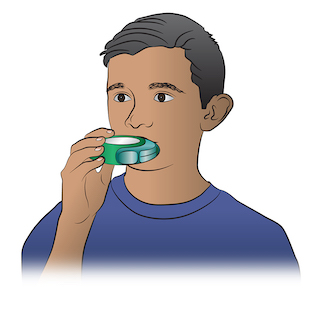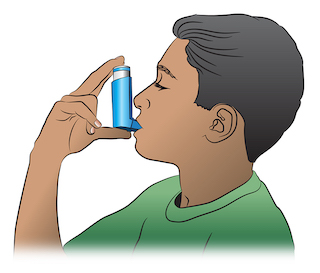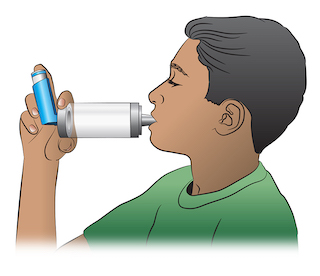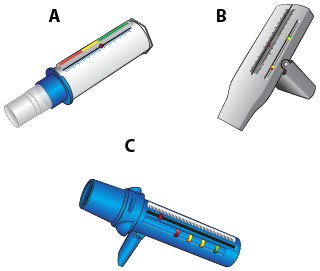Asthma Attack
Is this your child's symptom?
- Your child is having an asthma attack
- Use this guide only if a doctor has told you your child has asthma
Symptoms of Asthma
- Symptoms of an asthma attack are wheezing, a cough, tight chest, and trouble breathing.
- Wheezing is the classic symptom. Wheezing is a high-pitched whistling or purring sound. You can hear it best when your child is breathing out.
- The diagnosis of asthma requires attacks of wheezing that recur. The diagnosis is rarely made before 1 year of age.
Causes (Triggers) of Asthma Attacks
- Infections that affect breathing (like colds or the flu)
- Pollens (trees, grass and weeds)
- Animals (like cats or rabbits)
- Tobacco smoke
- Irritants (such as smog, car exhaust, menthol vapors, barns, dirty basement)
- Food Allergy (Serious). Asthma attacks caused by food allergy can be life-threatening (anaphylaxis). Examples are nuts or fish.
Asthma Attack Scale
- Mild: No Shortness of Breath (SOB) at rest. Mild SOB with walking. Can talk normally. Speaks in sentences. Can lay down flat. Wheezes not heard or mild. (Green Zone: Peak Flow Rate 80-100% of normal rate)
- Moderate: SOB at rest. Speaks in phrases. Wants to sit (can't lay down flat). Wheezing can be heard. Retractions are present (ribs pull in with each breath). (Yellow Zone: Peak Flow Rate 50-80% of normal rate)
- Severe: Severe SOB at rest. Speaks in single words. Struggling to breathe. Wheezing may be loud. Rarely, wheezing is absent due to poor air movement. Retractions may be severe. (Red Zone: Peak Flow Rate less than 50% of normal rate)
- Peak Flow Meter: a peak flow meter measures Peak Flow Rates (PFR). It tells us how well a person can move air out of the lungs. A PFR can be used in children 6 years and older.
Vaping and Lung Damage
- Talk with your teen about the dangers of vaping.
- Vaping can cause severe lung damage. It can become permanent.
- Vaping can even cause death (50 in the US in 2019).
- Vaping tobacco also causes nicotine addiction.
- For these reasons, the legal age to purchase vaping products is 21 in the US.
- Encourage your teen to not start vaping or to give it up.
- Warning: home-made or street-purchased vaping solutions are the most dangerous.
When to Call Us for Asthma Attack
Call 911 Now
Call Doctor or Seek Care Now
| Contact Doctor Within 24 Hours
Contact Doctor During Office Hours
| Self Care at Home
|
Care Advice for Asthma Attack
- What You Should Know About Asthma:
- Over 10% of children have asthma.
- Your child's asthma can flare up at any time.
- When you are away from your home, always take your child's medicines with you.
- The sooner you start treatment, the faster your child will feel better.
- Here is some care advice that should help.
- Asthma Quick-Relief Medicine:
- Your child's quick-relief (rescue) medicine is albuterol or xopenex.
- Start it at the first sign of any wheezing, shortness of breath or hard coughing.
- Give by inhaler with a spacer (2 puffs each time) or use a neb machine.
- Repeat it every 4 hours if your child is having any asthma symptoms.
- Never give it more often than 4 hours without talking with your child's doctor.
- Coughing. The best "cough med" for a child with asthma is always the asthma medicine. Caution: don't use cough suppressants. If over 6 years old, cough drops may help a tickly cough.
- Caution: if the inhaler hasn't been used in over 7 days, prime it. Test spray it twice into the air before using it for treatment. Also, do this if it is new.
- Use the medicine until your child has not wheezed or coughed for 48 hours.
- Spacer. Always use inhalers with a spacer. It will get twice the amount of medicine into the lungs.
- Asthma Controller Medicine:
- Your child may have been told to use a controller drug. An example is an inhaled steroid.
- It's for preventing attacks and must be used daily.
- During asthma attacks, keep giving this medicine to your child as ordered.
- Allergy Medicine for Hay Fever:
- For signs of nasal allergies (hay fever), it's okay to give allergy medicine. Reason: poor control of nasal allergies makes asthma worse.
- Fluids - Offer More:
- Try to get your child to drink lots of fluids.
- Goal: keep your child well hydrated.
- Reason: it will loosen up any phlegm in the lungs. Then it's easier to cough up.
- Humidifier:
- If the air in your home is dry, use a humidifier. Reason: dry air makes coughs worse.
- Avoid Tobacco Smoke:
- Tobacco smoke makes asthma much worse.
- Don't let anyone smoke around your child.
- Avoid or Remove Triggers:
- Shower to remove pollens or other allergens from the body and hair.
- Avoid known causes of asthma attacks (such as smoke or cats).
- During attacks, reduce exercise or sports if it makes your child's asthma worse.
- What to Expect:
- If treatment is started early, most asthma attacks are quickly brought under control.
- All wheezing should be gone by 5 days.
- Inhaler With a Spacer: How to Use
- Step 1. Shake the inhaler well. Then attach it to the spacer (holding chamber).
- Step 2. Breathe out completely and empty the lungs.
- Step 3. Close the lips and teeth around the spacer mouthpiece.
- Step 4. Press down on the inhaler. This will put one puff of the medicine in the spacer.
- Step 5. Breathe in slowly until the lungs are full.
- Step 6. Hold a deep breath for 10 seconds. Allow the medicine to work deep in the lungs.
- If your doctor has ordered 2 or more puffs, wait 1 minute. Then repeat steps 1-6.
- Metered Dose Inhaler (MDI): How to Use Without a Spacer (if you don't have one)
- Step 1. Shake the inhaler well.
- Step 2. Breathe out completely and empty the lungs.
- Step 3. Close the lips and teeth around the inhaler mouthpiece.
- Step 4. Press down on the inhaler to release a puff. Do this just as your child starts to breathe in.
- Step 5. Breathe in slowly until the lungs are full.
- Step 6. Hold a deep breath for 10 seconds. Allow the medicine to work deep in the lungs.
- If your doctor has ordered 2 or more puffs, wait 1 minute. Then repeat steps 1-6.
- Ask your doctor for a spacer if you don't have one. It will help send more medicine into the lungs.
- Older children who don't like a spacer can be prescribed an albuterol dry powder device.
- Home Nebulizer: How to Use:
- A nebulizer machine changes a liquid medicine (med) into a fine mist. The fine mist can carry the med deep into the lungs. This is called a nebulizer (neb) treatment.
- Step 1. Prepare the medicine. First, wash your hands with soap and water. For pre-mixed single dose vials, just add one vial to the neb holding cup. For multi-dose vials, you need to do the mixing. First, add the correct amount of normal saline to the neb cup. Then carefully measure and add the correct amount of medicine to the saline.
- Step 2. Connect the nebulizer to the air compressor tubing. The air compressor is run by electricity. Portable ones run on a battery. Compressors make the jet of air that turns the medicine into a fine mist.
- Step 3. Turn on the air compressor. It will start making the fine mist that your child needs.
- Step 4 for an Older Child. Place the mouthpiece between your child's teeth and seal with the lips. Ask your child to breathe slowly and deeply. Ask your child to hold a deep breath for 10 seconds once a minute.
- Step 4 for a Younger Child. If your child refuses the mouthpiece, use a face mask. It should cover the nose and mouth. It should fit snugly.
- Step 5. Continue the treatment until the med is gone. If the med sticks to the side of the cup, shake it a little. An average neb treatment takes 10 minutes.
- Step 6. After each treatment, take the nebulizer apart. Rinse and clean it as directed. Reason: it can't produce mist if it becomes clogged up.
- Caution: closely follow your doctor's instructions. Use the exact amount of med your doctor ordered. Don't give a neb treatment more often than every 4 hours.
- Call Your Doctor If:
- Trouble breathing occurs
- Asthma quick-relief medicine (neb or inhaler) is needed more than every 4 hours
- Wheezing lasts over 24 hours
- You think your child needs to be seen
- Your child becomes worse
And remember, contact your doctor if your child develops any of the 'Call Your Doctor' symptoms.
Disclaimer: this health information is for educational purposes only. You, the reader, assume full responsibility for how you choose to use it.

Dry powder inhalers require a different inhaling technique than regular metered dose inhalers (MDI). To use a dry powder inhaler, it is important to close your mouth tightly around the mouthpiece of the inhaler and to inhale rapidly. Here are the steps:
- STEP 1 - Remove the cap and follow package instructions to load a dose of medicine.
- STEP 2 - Breathe out completely.
- STEP 3 - Put the mouthpiece of the inhaler in the mouth.
- STEP 4 - Breathe in quickly and deeply.
- STEP 5 - Hold your breath for ten seconds to allow the medicine to reach deeply into your lungs.
- If your doctor has prescribed two or more inhalations, wait 1 minute and then repeat steps 2-5.

A metered dose inhaler (MDI) is a device used to deliver asthma medicine into the lungs. To be sure to deliver the medicine effectively, use the following steps:
- STEP 1 - Remove the cap and shake the inhaler.
- STEP 2 - Hold the inhaler about 1-2 inches in front of the mouth. Breathe out - completely.
- STEP 3 - Press down on the inhaler to release the medicine as you start to breathe in slowly.
- STEP 4 - Breathe in slowly for three to five seconds.
- STEP 5 - Hold your breath for ten seconds to allow the medicine to reach deeply into your lungs.
- If your doctor has prescribed two puffs, wait 1 minute and then repeat steps 2-5.

A spacer (or holding chamber) can be useful for all people with asthma. A spacer makes it easier to correctly inhale the asthma medicine from the metered dose inhaler (MDI). A spacer is very useful in younger children and older adults.
- STEP 1 - Shake the inhaler and then attach it to the spacer (holding chamber).
- STEP 2 - Breathe out completely.
- STEP 3 - Place the mouthpiece of the spacer in your mouth.
- STEP 4 - Press down on the inhaler. This will put one puff of the medicine in the holding chamber or spacer.
- STEP 5 - Breathe in slowly for 5 seconds.
- STEP 6 - Hold your breath for 10 seconds and then exhale.
- If your doctor has prescribed two or more puffs, wait 1 minute between each puff and then repeat steps 1-6.

Every adult with asthma should have a peak flow meter. A peak flow meter measures how well air moves out of your lungs. The number that is obtained is called the peak expiratory flow rate (PEFR). The "personal best" value is the highest PEFR number that a person obtains when they are feeling well.
Here is how to use a peak flow meter:
- STEP 1 - Move the indicator to the bottom of the numbered scale. Stand up.
- STEP 2 - Take a deep breath, filling your lungs completely.
- STEP 3 - Place the mouthpiece in your mouth and close your lips around it. Do not put your tongue inside the hole.
- STEP 4 - Blow out as hard and fast as you can.
- STEP 5 - Repeat the process two more times.
- STEP 6 - Write down the highest of the three numbers.
Using a Peak Flow Meter to Determine the Severity of an Asthma Attack:
- GREEN Zone - MILD Attack: PEFR 80-100% of personal best
- YELLOW Zone - MODERATE Attack: PEFR 50-80%
- RED Zone - SEVERE Attack: PEFR less than 50%
Copyright 2000-2023. Schmitt Pediatric Guidelines LLC.
Symptom Checker

